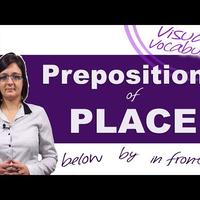Prepositions of Place - Visual Vocabulary Lesson
Hi, I'm Kasia.
Welcome to Oxford Online English!
In this lesson, you can learn about prepositions of place in English.
You can see how to use several different prepositions and prepositional phrases to say where something
is.
In this video, we won't go into detail on the prepositions ‘at', ‘on' and ‘in'.
We'll make a separate video for these three, because that's a big topic by itself.
Maybe we've already published the video – check our channel to see if it's there!
Before we start, don't forget to visit our website: Oxford Online English dot com.
You can see all our free English lessons, and also book classes with one of our professional
teachers, in case you need extra help with your English.
Also, don't forget to turn on subtitles!
This video has subtitles in English, and possibly in other languages, too.
Click ‘CC' in the bottom right corner of your video player now.
Ready to start?
Let's see how to use prepositions of place in English.
The egg is in the bowl.
Or, the egg is inside the bowl.
The egg is on top of the bowl.
‘In' and ‘inside' generally have the same meaning.
If you can choose, then it's better to use ‘in'.
Use ‘inside' when you want to emphasise that something is surrounded on all sides
For example, Inside an egg, you can find two parts: the
white and the yolk The egg is in front of the bowl.
The egg is behind the bowl.
The egg is on the left of the bowl The egg is on the right of the bowl.
You can also say ‘to the left' or ‘to the right'.
There's no difference in meaning The egg is next to the bowl.
The egg is near the bowl.
‘Next to' and ‘near' are similar, but not the same.
‘Next to' is more precise.
If you say ‘The egg is next to the bowl', you mean that there isn't much space between
the bowl and the egg.
They're very close to each other.
‘Near' is less precise.
If you say ‘The egg is near the bowl', you mean that there isn't a lot of distance
between the bowl and the egg, but it doesn't tell you exactly how close they are.
You can also use ‘beside' and ‘by', which are similar to ‘next to'.
‘Next to' is more common in most situations.
So, you can say ‘The egg is next to the bowl'.
Or, the egg is beside the bowl.
Or, the egg is by the bowl.
All three have the same meaning, although in practice, you would probably always use
‘next to'.
If you're not sure, use ‘next to'!
What about ‘near'?
‘Near' could mean closer, or further away.
‘The egg is near the bowl' could mean that the egg is in many different positions.
The egg is between the bowls.
The egg is among the bowls.
‘Between' and ‘among' both have the meaning of ‘in the middle of' or ‘surrounded
by' ‘Between' is more specific.
‘Between' means in the middle of *two* things.
‘Among' means in the middle of many things.
He's holding the egg over the bowl.
He's holding the egg above the bowl.
He's holding the egg under the bowl.
He's holding the egg below the bowl.
‘Over' and ‘above' are similar as prepositions of place.
Often, you can use either preposition, and the meaning is the same.
Be careful; if you're talking about *movement*, then ‘over' and ‘above' are different.
‘Over' and ‘under' are opposites.
‘Above' and ‘below' are opposites.
Like ‘over' and ‘above', ‘under' and ‘below' are often the same.
‘Often' the same?
So, when are they different?
There's one important difference.
If something completely covers something else, you can only use ‘over' and ‘under'.
He put the bowl over the egg.
The egg is under the bowl.
You need to use ‘over' and ‘under' because the bowl covers the egg completely.
The bowls are opposite each other.
Use ‘opposite' when two things are on different sides of something else.
For example, if you're sitting at a table, and I'm sitting on the other side, facing
you, then we're sitting *opposite* each other.
You can also say ‘across from', which is more conversational but has the same meaning.
That's the end of the lesson.
Thanks for watching!

